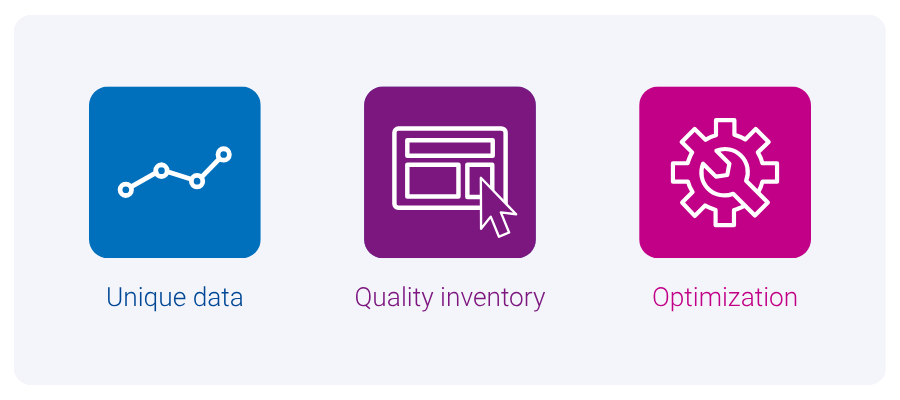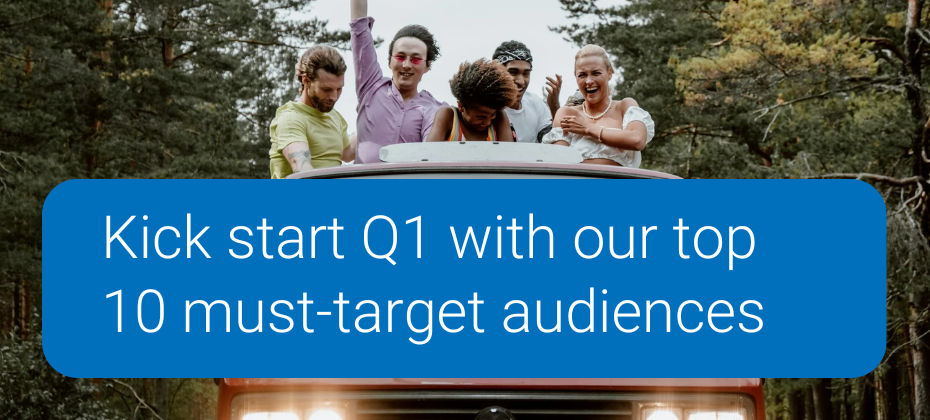At A Glance
Curation is changing how media is bought and sold, moving beyond open auctions and static site lists to more efficient deals. By combining unique data, real-time supply connections, and continuous optimization, curated PMPs reduce waste and improve results. Audigent's, a part of Experian, solutions help marketers achieve measurable outcomes with curated strategies that deliver better targeting, higher engagement, and improved ROI.If you buy media today, you’re already feeling the shift: the best results don’t always come from broad, open auctions or static “safe site” lists; they’re coming from deals that combine the right data with the right inventory and let algorithms optimize in real time. That’s curation. And when it’s done right, it reduces data and media waste for buyers and raises eCPMs (effective cost per thousand impressions) and win rates for publishers.

As part of our Cannes Content Studio series, leaders from Butler/Till, Index Exchange, OpenX, PubMatic, and Yieldmo discuss how curation cuts waste and lifts results.
What is real curation?
Real curation isn’t “packaging inventory.” It’s a strategic framework built on three pillars:
Why it matters: Manual approaches hit a ceiling. They can’t react quickly to shifting content, identity signals, or auction dynamics. That’s where technology partners come in, keeping the optimization loop running continuously.
Intelligence at every touchpoint
Curation isn’t about shifting control between platforms. It’s about better brand decisions, connecting opportunity-rich supply to the brand’s preferred buying platform and enriching each buy with audience data.In practice, supply-side platforms (SSPs) are ingesting richer signals to route inventory more effectively and support frequency caps and deal prioritization, in collaboration with demand-side platforms (DSPs).
“I think we’re seeing a shift toward bringing more DSP capabilities into the SSP, like supply-side targeting and data driven curation. Advancements in areas like CTV are enabling targeting based on content signals, and SSPs are pulling in more data to inform which supply is sent to the DSP, helping with things like frequency caps.”
OpenXMatt Sattel
Why page-level targeting beats static lists
Static domain lists were a useful first step for quality control. The intent was sound, but the approach was too cumbersome for today’s signal-rich buying. Today, AI and contextual engines read the page, not just the site, and adapt in real time.

Page-level logic delivers three key benefits:
- Accuracy by targeting high-intent, page-level content.
- Relevance by matching the creative to both the content and the audience context.
- Speed by enabling campaigns to move away from underperforming pages in real time, without waiting for a manual trafficking change.
“AI-driven contextual engines evaluate the page, not just the domain, to curate inventory in real time. That moves curation from static allowlists to adaptive logic for greater accuracy, relevance, and speed.”
YieldmoSophia Su
Partnerships broaden who influences the buy

Curation works when publishers, agencies, data partners, and platforms share signals and KPIs.
- Horizontal curation (across multiple SSPs) assembles broader, higher-quality reach and resilience, ideal for scale and diversity of supply.
- Vertical curation (an SSP’s in-house product) provides deep controls within a single exchange, useful for specific inventory strategies.
- Creative and data now shape supply and demand: better creative decisioning, tested against richer signals, improves outcomes.
DSPs remain central for activation and pacing. But the sell-side’s growing intelligence means more accurate inventory routing and signal application before a bid ever fires.
“Curation will continue to evolve through deeper data partnerships and expanded use across publishers and agencies, with more sophisticated types of optimization. DSPs will remain critical to activation, even as sell-side decisioning plays a larger role in identifying and shaping the supply to select.”
Index ExchangeMike McNeeley
Curation delivers access and measurable performance

Here’s what curated deals are delivering.
For buyers
| Result | Type of result |
| 36-81% | savings on data segments |
| 10-70% | lower cost per click (CPCs) |
| 1.5-3x | higher click-through rates (CTRs) |
| 10-30% | higher video completion rates |
For publishers
| Result | Type of result |
| 20% | bid density |
| 118% | win rate |
| 10% | revenue on discovered inventory |
| 25% | eCRM on incremental impressions |
Why it works: When data, supply, and optimization are integrated, you reduce waste, surface better impressions, and let algorithms compound your advantage. That’s why curated private marketplaces (PMPs) have grown at ~19% compound annual growth rate (CAGR) since 2019.
“Publishers using supply-side curation see ~15% more diverse buyers and 20–25% better performance than buy-side-only targeting. Smarter packaging and signal application tighten auctions and strengthen outcomes.”
PubmaticHoward Luks
Holistic curation streamlines planning and outcomes

Curation adds the data layer earlier in the buying process, starting at the supply-side. This creates more opportunities to reach the right audience and improves scale and performance. By replacing multiple line items with a single curated deal, campaign setup becomes faster and less error-prone. Curated deals also simplify measurement by including the necessary context for accurate attribution, while dynamic adjustments ensure campaigns remain optimized without requiring manual updates.
“Publishers using supply-side curation see ~15% more diverse buyers and 20–25% better performance than buy-side-only targeting. Smarter packaging and signal application tighten auctions and strengthen outcomes.”
Butler/TillGina Whelehan
It’s much more streamlined, bringing more pieces together so we’re thoughtful and holistic. Adding the audience and data element creates more scale and strategy in how we curate supply and data, and ultimately better results for clients.
The bottom line
Curation has matured from buzzword to performance system. DSPs still anchor activation and pacing, but better sell-side pipes now pre-route inventory and apply signals before any bid starts, making the whole system faster and more accurate. When you combine unique signals, tight supply connections, and always-on optimization, you gain addressability, reduce waste, and achieve better business outcomes for both buyers and sellers.
Curation isn’t just a trend; it’s where programmatic advertising is headed. Start testing curated PMPs today to see the difference for yourself.
Explore curated PMPs with Audigent
Curation FAQs
Curation in performance marketing is the process of combining data, inventory, and optimization to deliver better results. Audigent supports curated strategies through privacy-safe data and advanced integrations.
Curation reduces wasted spend by targeting high-quality impressions and optimizing campaigns in real time. Audigent’s solutions help marketers achieve higher click-through rates, lower costs, and better engagement across channels.
Curated PMPs are deals that use curated data and inventory to deliver measurable results. They help buyers save on data costs, improve ad performance, and achieve better video completion rates, while publishers see higher win rates and revenue.
Audigent provides unique data assets, privacy-safe integrations, and optimization tools that help marketers and publishers create curated deals. Our solutions ensure campaigns are more efficient, targeted, and effective from start to finish.
Horizontal curation combines inventory across multiple platforms for broader reach and diversity, while vertical curation focuses on deep control within a single platform. Both approaches can be tailored to specific campaign goals with Audigent’s expertise.
Latest posts

Note: This Ask the Expert was recorded prior to Experian’s acquisition of Audigent and discusses industry trends and how we’ve worked together in the past. Adopting new strategies based on trust due to evolving privacy regulations and the gradual loss of traditional signals, like third-party cookies, is essential to successfully navigating the future of digital advertising. Advertisers and marketers are at a crossroads, facing the challenge of maintaining personalization and precision while respecting consumer expectations around privacy. To stay competitive, brands must adopt future-ready strategies that focus on trust, privacy-forward technologies, and scalable solutions. In our latest Ask the Expert segment, recorded before Experian acquired Audigent, we explore how first-party data and advanced contextual audience targeting are two critical approaches for successfully navigating these changes. With insights from Greg Williams, President of Audigent, now part of Experian, and Crystal Jacques, VP of Sales at Experian, we discuss how these tools can empower your brand for long-term success. First-party data as a cornerstone strategy First-party data, a powerful tool for building meaningful connections with your audience, has emerged as a fundamental pillar of future-ready strategies. When collected and used effectively, it provides brands with a detailed understanding of consumer preferences and behaviors, enabling real-time campaign adjustments for maximum impact. “Data has become part of every step of the digital advertising supply chain, and should be part of everybody’s buys… the more you can include data in your digital marketing, the better off and the more power you have."Greg Williams, President, Audigent With the continual loss of signal, including third-party cookies, first-party data has proven to be key for brands to stay both competitive and privacy-compliant. Brands using first-party data are better positioned to overcome the challenges of signal loss. This data facilitates improved media targeting and personalized messaging, driving greater engagement and return on investment. Contextually-Indexed Audiences build relevance Experian’s Contextually-Indexed Audiences enable advertisers to target users based on their interests in real-time, without relying on cookies or mobile ad IDs. Machine learning analyzes and maps traffic from over two million websites, linking to Experian’s 2,400 audience segments. With added benefits like audience customization and flexible activation through Audigent’s private marketplaces (PMPs) or demand-side platforms, Experian is setting a new standard for scalable audience targeting. For automotive advertisers, this could mean reaching consumers actively researching luxury electric vehicles on relevant sites. Unlike outdated methods, contextual targeting aligns the message with consumer intent, balancing high precision with consumer privacy. Automotive success story Audigent’s innovative solutions have delivered tangible results. Williams mentions how they helped an automotive brand achieve double the scale and triple their goal of driving test drives. This stands as a testament to the real-world effectiveness of contextual audience strategies and Experian's role in executing them. How to stay ahead of change Here are five strategies to help your brand remain future-ready amid privacy challenges and signal loss: Prioritize first-party data: Build trust and improve targeting accuracy by relying on data that you own directly from your consumers. Test privacy-forward tools: Experiment with solutions like contextual targeting and Google’s Privacy Sandbox to future-proof your advertising. Strengthen identity framework: Create systems to securely manage and use data for cross-channel decision making. Use scalable tools: Partner with trusted providers to deploy solutions that adapt to changing industry standards. Stay proactive and flexible: Continuously evaluate trends and refine approaches to align with emerging consumer and regulatory expectations. A deeper conversation For additional insights, watch our full Q&A. Greg Williams and Crystal Jacques discuss the future of audience targeting, how first-party data reshapes marketing strategies, and how Experian and Audigent have collaborated in the past. Watch now Contact us About our experts Greg Williams, President, Audigent Greg Williams is Audigent's President, responsible for managing Audigent’s vast portfolio of ecosystem partners, enterprise sales, marketing, and client success. An innovator in programmatic ad buying, Williams co-founded MediaMath and was instrumental in building and scaling that company in the US and internationally. He led MediaMath's international expansion in 2011 and grew that business from zero to a top revenue driver for the company in three years. During his 14 years at the company, Williams held global roles and built teams across every function of the organization — most notably leading business and market development, product development, and partnerships. Prior to co-founding MediaMath, Williams held senior positions at [X+1] (which was later acquired by RocketFuel), Nielsen, and Accenture. Crystal Jacques, Head of Enterprise Sales, Experian Head of Enterprise Partnerships, leading Experian's go-to-market team across all verticals. With over ten years of experience in the Identity space, Crystal brings a wealth of expertise to her role. She joined Experian in 2020 through the Tapad acquisition, following her successful stint as the head of Global Channel Partnerships for Adbrain, which The Trade Desk later acquired. Latest posts

CES 2025 will be an exciting opportunity to explore how we can work together to shape the year ahead. Here are four themes we expect to take center stage at the event. “There is no better way to kick off the calendar year than with clients and industry peers that are excited to collaborate on new business opportunities. People come straight off the holidays energized by CES and with a pipeline of deals to work on for the coming month. In-person meetings always trump virtual calls and everyone in the industry comes together to make it a fruitful week.”Crystal Jacques, Head of Enterprise Partnerships 1. Addressability in a signal-loss world Addressability has become a cornerstone in AdTech as brands aim to deliver personalized experiences while navigating evolving privacy regulations and signal loss. This shift has prompted advertisers to rethink how they reach and engage audiences. In this environment, alternative identifiers such as UID2 and ID5 have gained traction, offering brands new avenues to target consumers across platforms while respecting privacy. Addressability has shifted from a straightforward tracking mechanism to a multifaceted strategy that combines identity solutions, contextual insights, and collaboration across the ecosystem. ID Bridging and the new OpenRTB 2.6 specs As the industry loses identity signals, it becomes increasingly difficult to identify audiences on the supply-side and make them reachable for the demand-side. The supply-side has used the practice of ID bridging to do just that. ID bridging is the supply-side practice of connecting the dots between available signals to infer a user’s identity and communicate it to prospective buyers. This practice sparked debate, as buyers want full transparency into the use of a deterministic identifier versus an inferred one. "The OpenRTB 2.6 specifications are a critical step forward in ensuring transparency and trust in programmatic advertising. By aligning with these standards, we empower our partners with the tools needed to navigate a cookieless future and drive measurable results.”Michael Connolly, CEO, Sonobi The industry needs widely accepted standards, and that's what we believe the industry has with the IAB Tech Lab's OpenRTB 2.6. The specifications dictate the data the supply-side needs to include in the Primary ID and Enhanced Identifier (EID) fields. In doing so, the demand-side receives more transparent information on when bids have inferred IDs and where they came from. As authenticated signals decrease due to cookie deprecation and other consumer privacy measures, we will continue to see a rise in inferred identifiers. Experian’s industry-leading Digital Graph has long supported both authenticated and inferred identifiers, providing the ecosystem with connections that are accurate, scalable, and addressable. Experian will continue to support the industry with its identity resolution products and is very supportive of IAB’s efforts to bring transparency to the industry around the usage of identity signals. 2. Commerce media consolidation As the world of commerce media expands beyond traditional retail media, we’re seeing a surge of networks across various verticals—financial, travel, and beyond—all competing to capture shoppers’ attention. With each company independently building its own media network, the need for strategic partnerships has never been more evident. Key players face challenges in scaling these networks and meeting growth targets due to infrastructure and funding limitations. In response, the industry is shifting toward partnerships – and potentially consolidation – to create networks that allow advertisers to reach customers across the entire shopping journey – from digital to in-store. To succeed, commerce media networks must form strategic partnerships to enhance their data and identity capabilities and provide advertisers with a complete view of their customer. “With annual growth in billions of dollars, the revenue potential for RMNs is massive. Organizing customer data, segmenting customers, generating insights, creating addressable audiences, and activating campaigns are all critical steps for a RMN to realize that revenue potential. RMNs should select a partner that provides the data, identity and analytical resources to create the winning formula for marketers, customers and retailers.”Steve Zimmerman, Director of Analytics With Experian’s expertise in data and identity solutions, commerce media networks can overcome data fragmentation, create high-quality audiences, and maximize addressability across their entire customer base. This collaborative, partner-led approach empowers retailers to utilize their first-party customer data but not be limited by in-house resources. As the commerce media space matures, those who embrace these partnerships and data-driven solutions will be well-positioned to capture the full potential of this expanding market. 3. Navigating complex privacy regulations With privacy concerns intensifying, consumers are more conscious about data usage, and a series of state-level privacy laws are poised to take effect across the U.S. Multiple state-level laws makes compliance more challenging for marketers since no two laws are the same. While a federal privacy law remains unlikely for 2025, discussions around data ethics, compliance, and transparency will be prominent at CES, especially as a new administration assumes office. Our privacy-forward audience solutions Our Geo-Indexed and Contextually-Indexed Audiences help marketers reach the right consumers while prioritizing data privacy. Created without sensitive personal information, these audiences utilize geographic and contextual signals – not personal identifiers — to offer relevant targeting. These new tools provide both privacy and accuracy, giving advertisers and publishers a competitive edge. “By embracing innovations in geo-based targeting and adhering to responsible data strategies, you can not only comply with these laws but continue to reach your intended audiences effectively.”Jeremy Meade, VP, Marketing Data & Operations As privacy regulations evolve, marketers need trusted allies who can provide transparent, compliant solutions. With deep roots in data protection and security, you can confidently partner with Experian as we proactively stay ahead of regulations and strictly follow all consumer privacy laws. 4. Rise of curation As privacy regulations and signal loss reshape the AdTech ecosystem, curation can optimize programmatic campaigns by connecting advertisers with valuable audiences. This emerging trend utilizes audience, contextual, and supply chain signals to curate high-quality inventory packages for advertisers. By blending insights with inventory, curation ensures greater addressability, efficiency, and performance for both advertisers and publishers. Supply-side platforms (SSPs) are taking a more active role in curating audiences and inventory. SSPs now collaborate with data providers to match buyer and publisher first-party data in real-time, creating curated private marketplaces (PMPs) that deliver transparency, efficiency, and improved match rates. SSPs can send deal IDs to multiple DSPs, which allows advertisers to deploy audience-based campaigns without restrictions on which DSPs or identifiers can be used. However, curation isn’t without challenges. It can add complexity, lead to redundant buys, and even reduce publisher control over inventory. Transparency, quality benchmarks, and strategic partnerships will be critical for maximizing the benefits of curation in 2025. Experian, in partnership with Audigent and others, is at the forefront of enabling privacy-forward curation strategies. Experian and Audigent’s combined capabilities bring together first-party publisher data, contextual signals, and advanced identity resolution to create curated PMPs that empower marketers to deliver precise, impactful campaigns. Follow us on LinkedIn or sign up for our email newsletter for more informative content on the latest industry insights and data-driven marketing. What were the top themes at CES 2025? Read our CES recap to find out. Read now Contact us Latest posts

At Experian, we understand the importance of audience targeting when it comes to crafting a successful marketing campaign. We are excited to share a curated list of audience recommendations to support your campaign planning so you can confidently connect with your audience. What separates Experian’s syndicated audiences Experian’s 2,400+ syndicated audiences are available directly on over 30 leading television, social, programmatic advertising platforms, and directly within Audigent for activation within private marketplaces (PMPs). Reach consumers based on who they are, where they live, and their household makeup. Experian ranked #1 in accuracy by Truthset for key demographic attributes. Access to unique audiences through Experian’s Partner Audiences available on Experian’s data marketplace, within Audigent for activation in PMPs and directly on platforms like DirectTV, Dish, Magnite, OpenAP, and The Trade Desk. New and improved audience segments we recommend for Q1 campaigns Q1 is the ultimate season for TV, with the NFL playoffs, Super Bowl, College Football playoffs, award shows and so much more capturing viewers’ attention. That’s why we're excited to introduce 14 new and 8 updated television audiences. Recently released on major platforms, these new television audiences offer unique opportunities to align your campaign planning with the latest viewer behavior trends. Cable Satellite or Streaming Network Subscribers Satellite Service Subscribers Mutli Brand TV Owners Seasonal audiences for Q1 New Year’s audiences As the new year approaches, it’s the ideal moment to connect with consumers inspired by their New Year’s resolutions. In 2024, one-third of U.S. adults set goals for the year, focusing on key areas like healthier living, getting organized, exploring new experiences, and improving financial wellness. Experian’s New Year’s resolution audiences provide valuable insights into these aspirations, allowing you to tailor your messaging and engage with consumers determined to make positive changes in 2025. From promoting healthy lifestyles and travel to supporting organization and financial goals, Experian’s data-driven solutions help you capture these motivated audiences with precisely targeted messaging. Learn more here Football audiences Football season presents an unmatched opportunity for brands to connect with one of the most engaged audiences in the U.S. As in-game ad costs continue to rise and slots fill up quickly, brands are seeking innovative ways to reach passionate football viewers beyond the game. Experian’s specialized football audience segments allow advertisers to engage with fans across categories like NFL stadium visitors, college football enthusiasts, beer drinkers, and dedicated TV viewers, ensuring your brand connects meaningfully with consumers throughout the season. Read more here Financial audiences With tax season just around the corner, brands have the opportunity to connect with financially engaged audiences in the U.S. Whether your goal is to reach self-starters managing their own returns or high-net-worth individuals seeking advanced tax solutions, Experian can ensure your brand connects meaningfully with the right financial audience at the right time. Experian’s specialized financial audience segments empower brands to engage with key groups, such as: Tax Return – Self prepare user Tax Return – Online tax software user Tax Return – Professional Service Preparer user Savvy Sounding-Board Seeking Investor Price Sensitive, Self-Directed Investor Top recommendations for Q1 Based on the top Experian audiences activated in Q1 of 2024, our top 10 list is designed to assist agencies and media buyers plan data-driven advertising campaigns. Occupation 1) Small Business Owners: This segment contains consumers who are likely to be small business owners. 2) Military – Inactive: This segment contains consumers who are likely to be inactive in the military. 3) Legal/Education and Health Practitioners: This segment contains consumers who are likely to have an occupation in Legal/Education and Health Practitioner. 4) Technical: Computers/Math and Architect/Engineering: This segment contains consumers who are likely to have an occupation in Computers/Math and Architect/Engineering. Consumer Lifestyles 5) Vacation/Leisure Travelers: Weekend Getaways: This segment contains consumers who are likely high spenders or frequent purchasers of weekend getaway travel. 6) Women's Sleepwear and Lingerie: High Spenders: This segment contains consumers who are likely high spenders at women's sleepwear and lingerie stores (e.g., Soma, Victoria's Secret). 7) Smart Investors: This segment contains consumers who are likely actively seeking out as much information about an investment as possible before committing, shopping around for the best investment deal, and aversion to financial debt. 8) Computers/Software Frequent Spenders: This segment contains consumers who are likely frequent spenders of computer software. Life Events 9) New Movers: High Spenders: This segment contains consumers who are likely new mover high spenders. 10) New Parents: Child Aged 0-36 Months: This segment contains consumers who are likely to be new parents for children aged 0-36 months. You can find the complete audience segment name in the appendix. Activate the right audiences with Experian For a full list of Experian’s syndicated audiences and activation destinations, download our syndicated audiences guide. Need a custom audience? Reach out to our audience team and we can help you build and activate an Experian audience on the platform of your choice. Connect with our audience team Contact us Appendix Here are the complete audience segment names (taxonomy paths) for all audience segments discussed in this blog post. TV Audiences Television (TV) > Household/Family Viewing > Cable Satellite or Streaming Network Subscribers Retail Shoppers: Purchase Based > Seasonal > Discount Holiday Shoppers Television (TV) > Brand Owners > Multi Brand TV Owners Financial Audiences Lifestyle and Interests (Affinity) > Financial Behavior > Tax Return – Self prepare user Lifestyle and Interests (Affinity) > Financial Behavior > Online Tax Software user Lifestyle and Interests (Affinity) > Financial Behavior > Tax Return –Professional Service Prepare user Financial Personalities > Investments Financial Personality > Savvy Sounding-Board Seeking Investor, Average Investable Assets Financial Personalities > Investments Financial Personality > Price Sensitive, Self-Directed Investor, Very High Investable Assets Occupation Consumer Behaviors > Occupation: Small Business Owners Lifestyle and Interests (Affinity) > Occupation > Military – Inactive Demographics > Occupation > Professional: Legal/Education and Health Practitioners Demographics > Occupation > Technical: Computers/Math and Architect/Engineering Consumer Lifestyles Retail Shoppers: Purchase Based > Travel > Vacation/Leisure Travelers: Weekend Getaways Retail Shoppers: Purchase Based > Apparel > Women's Apparel (Clothing): Women's Sleepwear and Lingerie: High Spenders Financial Behavior > Smart Investors Retail Shoppers: Purchase Based > Technology/Telecom > Computers/Software Frequent Spenders Life Events Retail Shoppers: Purchase Based > Shopping Behavior > New Movers: High Spenders Life Events > New Parents > Child Age 0-36 Months Latest posts


